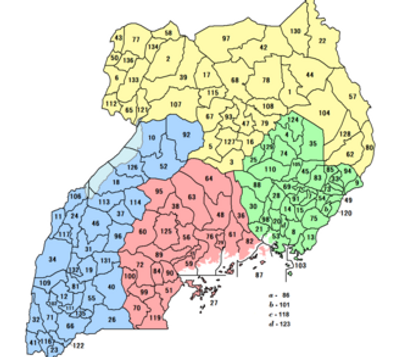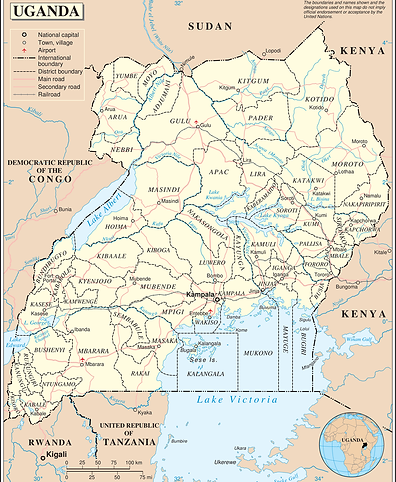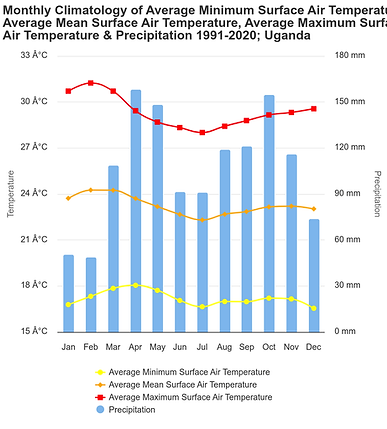
BRIEF HISTORY
The Country was largely monarchical in nature.
Most of its sub-regions were split into different Kingdoms ruled by chiefs who doubled as political and cultural leaders. The country's diverse ethnic groups and cultures have shaped its history.
-
Pre-colonial Uganda : Before European colonization, Uganda was home to various kingdoms and ethnic groups. The Kingdom of Buganda was particularly influential. From 1886, there was a series of religious wars in Buganda. British commercial interests were ardent to protect the trade route of the Nile, which prompted the British government to annex Buganda and adjoining territories to create the Uganda Protectorate in 1894.
-
Uganda Protectorate (1894–1962) : The British introduced new systems of administration and economic development.
-
Independence (1962 to 1965) : Uganda gained independence from Britain on 9th October 1962. Milton Obote became the first Prime Minister.
-
Political Instability (1962–1966) : The years following independence were marked by political instability, coups, and civil wars. In 1966, following a power struggle, Obote suspended the constitution and removed the ceremonial president and vice-president. In 1967, a new constitution proclaimed Uganda a republic and abolished the traditional kingdoms. Obote was declared the president.
-
Amin Regime (1971-1979) : In 1971, General Idi Amin Dada seized power in a military coup. His brutal dictatorship led to the deaths of hundreds of thousands of Ugandans. Amin's reign was ended after the Uganda-Tanzania War in 1979, in which Tanzanian forces aided by Ugandan exiles invaded Uganda.
-
Post-Amin Era (1979-present) : After Amin's overthrow in 1979, Uganda experienced a period of reconstruction and attempted to return to democratic rule. In 1980’s, the country suffered guerrilla wars as different governments took over power only to be ousted before long. President Yoweri Museveni has ruled the country since 1986 and he was latest re-elected in January 2021 presidential elections. In recent years, Peace has been fully restored in the country. Uganda has made significant strides in economic growth and development.
Actual Government and Politics
The Republic of Uganda is a Unitary presidential republic under a dominant-party authoritarian state.
• President : Yoweri Museveni
• Vice President : Jessica Alupo
• Prime Minister : Robinah Nabbanja
Uganda is a member of the East African Community (EAC), along with Kenya, Tanzania, Rwanda, Burundi, and South Sudan.
As of 2022, Uganda is divided into four Regions of Uganda and 136 districts.
Parallel with the state administration, five traditional Bantu kingdoms have remained, enjoying some degrees of mainly cultural autonomy. The kingdoms are Toro, Busoga, Bunyoro, Buganda, and Rwenzururu.


In 1996, Museveni was sworn as Uganda's first elected president (source : New vision).





GEOGRAPHY
The Pearl of Africa
Republic of Uganda
Capital : Kampala (a historical name that refers to “where the king goes hunting”)
Total area : 241,038 km² (93,065 sq mi)
Water area : 15,39%
Average altitude : 900 m (2953 feet) above sea level
Highest peak : 5091 m or 16703 feet (Alexandra peak in The Rwenzori Mountains National Park in the South-Wet of Uganda)
It is located in Sub-Saharan Africa, on the East African Plateau – zone of the East African Rift.
The country is neighboured by Kenya (East), Democratic Republic of Congo (West), Tanzania (South), Rwanda (South West) and Sudan (North).
The country is part of the African Great Lakes region and is one of the seven African countries split by the Equator into the Northern and Southern hemispheres.
Its geography is very diverse, consisting of volcanic hills, mountains, and lakes. This variety makes Uganda the Pearl of Africa :
“The kingdom of Uganda is a fairy-tale. You climb up … and at the end there is a wonderful new world. The scenery is different, the vegetation is different, the climate is different, and, most of all, the people are different from anything elsewhere to be seen in the whole range of Africa. For magnificence, for variety of form and colour, for profusion of brilliant life – bird, insect, reptile, beast – for vast scale — Uganda is truly the pearl of Africa.”
W. CHURCHILL, My African Journey.
Uganda is characterized by an important part of inland water. Bounded by Mountains (Rwenzori 5109m, Mount Elgond 4321m, Mgahinga 4127m) and freshwater water bodies, the country shares an important part of the Lake Victoria with Kenya and Tanzania.
The South-East part of the country is mainly covered by the Lake which influences the climate and the local livelihood. The city of Jinja (80km East Kampala) is known as the Source of the Nile since the declaration of the explorer JH Speke (1863). From Jinja, the River Nile flows successively through Lake Kyoga, Murchison Falls and Lake Albert making the Nile basin an important part of Uganda. Other lakes such as Lake Edouard and Lake Bunyonyi complete the long list of natural and protected area to explore.
The climate is largely tropical with two rainy seasons per year, March to May and September to December.
The northern region, which forms one quarter of the country lies outside the tropical belt, and hence experiences only one rainy season, March to October.
Temperatures may vary significantly during day and night from a season to another but also from a region to another during the same season. Uganda experiences moderate temperatures throughout the year, around 22.8°C, with monthly temperatures ranging between 21.7°C (July) and 23.9°C (February).
From western high top mountains with snow and frequent rains to the North semi-arid in nature, Uganda is gifted by a wide range of biodiversity.
Thanks to its strategic location and various climates, the country is the convergence of different African’s vegetation areas. It is partly for this reason that it attracts over :
- 50% of the continent bird’s species ;
- 10% of the world bird’s species. 60 important protected area.
10 National Parks are gazetted and promoted making Uganda a wonderful place to discover in many ways.
The national environment conservation policy is affecting positively the Ugandan wildlife by a net increase of the population in the protected area.
Two of Uganda’s national parks are recognized by UNESCO as World Heritage Sites :
-
Bwindi Impenetrable National Park
-
Rwenzori Mountains National Park.
DEMOGRAPHY
Some statistics
Total population
49,2 million (2024)
51% are female, 49% male.
55% of the population below 18 years old
23% of the population between 18/30 years old
Total Fertility Rate (TFR)
5.97 children per woman (2014)
Country’s Literacy Rate
72.2% (of the population aged 10 years and above)
69% of the households depend on Subsistence Farming as their main source of livelihood.
80% of the households are involved in Agriculture.
Population density
157.1 per/km² (406.9/sq mi)
The average annual population growth rate is 3.0%
Infant Mortality Rate (IMR)
61 deaths per 1000 children (2012)
Living area
Nearly one-quarter (25%) of the households is living in urban areas.
20% of the households have access to electricity



Par Jonipoon — File:Kampala skyline.jpgFile:In front of Gaddafi mosque, Kampala.jpgFile:Baha'i House of Worship, Kampala, Uganda.jpgFile:Kampalaskycraper.JPGFile:Makerere University - Kampala.jpgFile:Victoria lake.JPG, CC BY-SA 4.0, https://commons.wikimedia.org/w/index.php?curid=37932150
ECONOMY
Currency : Uganda shilling (UGX)
GDP total : 52.390 billion USD (2023) equivalent of 0,05% of the world economy
GDP per capita : 1,163 USD (2023)
Inflation average : 5.7% (2016/2017) and 3,4% (2017/2018)
Human Development Index (HDI) : 0.550 (159th over 193) in 2022 --> medium
Gini coefficient : 42 (2016) --> medium inequality
Economic growth
The country has been experiencing consistent economic growth.
In fiscal year 2015–16, Uganda recorded gross domestic product (GDP) growth of 4.6% in real terms and 11.6% in nominal terms. This compares to 5% real growth in fiscal year 2014–15.
Uganda's 10 main exports (2019) :
- Coffee, tea, spices : 33.6%
- Fish : 12,4%
- Dairy, eggs, honey : 10,3%
- Cocoa : 5,3%
- Live trees, plants, flowers: 4.7%
- Tobacco manufactured substitutes : 4.2%
- Oilseeds: 3.2%
- Wood: 2.9%
- Sugar : 2.9%
- Cotton: 2.5%
Uganda’s average unemployment rate was 1.8% for 2019, compared to 1.7% for 2018 according to Trading Economics.
Poverty
Uganda is one of the poorest nations in the world.
In 2012, 37.8% of the population lived on less than $1.25 a day.
Despite making enormous progress in reducing the countrywide poverty incidence from 56% of the population in 1992 to 24.5% in 2009, poverty remains deep-rooted in the country's rural areas, which are home to 84% of Ugandans.
People in rural areas of Uganda depend on farming as the main source of income and 90% of all rural women work in the agricultural sector.
Education
Uganda's educational system, while lacking in many areas, has seen significant change since the late 1990s.
In 1997, the government declared that primary school would be free for all children. Uganda in 2007 became the first country in sub-Saharan Africa to introduce universal secondary education (USE).This bold step by the Government of Uganda led to an increase in lower secondary enrolment of nearly 25% between 2007 and 2012.
At the 2002 census, Uganda had a literacy rate of 66.8 % (76.8% male and 57.7% female).
CULTURE
Owing to the large number of communities, culture within Uganda is diverse.
Culture of Uganda is made up of a diverse range of ethnic groups.
The Baganda : largest single ethnic group.
-
Localisation : Central part of Uganda, Buganda Province (include districts of of Kampala, Mpigi, Mukono, Masaka, Kalangala, Kiboga, Rakai, Mubende, Luwero, Wakiso, Ssembabule, and Buikwe).
-
Language : Luganda
The Lango and the Acholi peoples
-
Localisation : In the North of Uganda.
-
Language : Nilotic languages
The Iteso and Karamojong
-
Localisation : In the East of Uganda.
-
Language : Nilotic languages
The Gishu
-
Localisation : In the Bantu, mainly on the slopes of Mount Elgon.
-
Language : Lumasaba
The Pygmies
-
Localisation : Isolated in the rainforests of western Uganda
Language
Uganda is ethnologically diverse, with at least 40 languages in usage.
Most commun language : Luganda widespread in central Uganda.
Official languages : English (most popular) and Swahili (the East African lingua franca).
Education is conducted in English.
Religion
Christianism is the predominant religion in Uganda (85% of the population of which 39% are catholics and 32% anglicans ). 14% of the population adhered to Islam (sizeable numbers of Sikhs and Hindus were expelled in 1972 by Idi Amin and many are now returning following an invitation from President Yoweri Museveni).
Traditional culture
Ugandan traditions include folk music, dances, foods, clothing, and building styles, among others.
In Uganda, the kanzu is the national dress of men in the country. Women from central and eastern Uganda wear a dress with a sash tied around the waist and large exaggerated shoulders called a gomesi. Women from the west and north-west drape a long cloth around their waists and shoulders called suuka.
Women from the south-west wear a long baggy skirt and tie a short matching cloth across their shoulders. Women also wear a floor long dress called a busuti, which was introduced by the 19th century missionaries.
